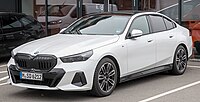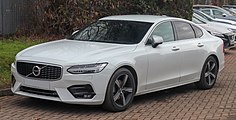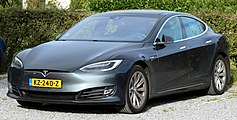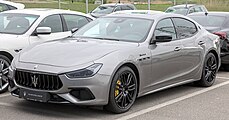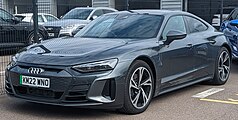|
E-segment2024 best-selling E-segment cars Mercedes-Benz E-Class 6th generation (2023-present) BMW 5 Series 8th generation (2024-present) Audi A6 5th generation (2018–present) Volvo S90 1st generation (2016-present) The E-segment is the 5th category of the European segments for passenger cars, synonymous with the term executive car.[1][2][3] E-Segment is a niche in Europe (2-3% penetration in 2010s). In 2017, 2018, 2019 and 2020, E-segment sales accounted for 2.7%, 2.7%, 2.3% and 2.1% market share in Europe, respectively.[4][5][6][7] CharacteristicsMost E-segment cars are sedans/saloons, however several models are also produced in other body styles such as wagons/estates. As of 2021, E-segment cars typically have a length of approx. 4.8m to 5m. European vs. American classificationThe terms E-segment or executive car do not have a one-to-one equivalent in the American car classification. However, if a modern E-segment sedan by a European brand is sold in the U.S., it falls into the category of both mid-size and full-size sedan, usually a mid-size luxury sedan. The American mid-size sedan classification[note 1] spans both the D-segment and the E-segment. With size brackets of European car segments increasing, the Toyota Camry fell from the E-segment[8] into the D-segment while remaining a mid-size car. Current modelsIn 2020, the highest selling E-segment cars in Europe were the Mercedes-Benz E-class, BMW 5 Series, Audi A6, Volvo V90/S90 and Porsche Taycan.[9] 50.000 - 100.000 sales (Best-Selling)
10.000 - 50.000 sales
Fewer than 10.000 sales
Moved to F-segment
Sales figures in Europe
Notes: 1. The table includes not only E-segment cars, but also a car fitting the F-segment in terms of size (the 2011 Chrysler 300). 2. Our source of information initial include BMW 8 Series in E-segment, but latter moved to F-segment. Market share in Europe2019 - Sales of large cars in Europe were down 13% in 2019 to 362,300 units, a new record low annual volume for this class, which now accounts for 2.3% of the total European car market, down from 2.7% in 2018. [18] 2020 - The large cars segment in Europe is down 32% in 2020, to just over 246,000 deliveries. This means the segment loses ground on the overall market again and now accounts for just 2.1% of the total European car market, down from 2.3% in 2019. With the exception of a newcomer, the entire top-8, which accounts for nearly 91% of the segment's sales, drops by 29% or more and thus falls behind the overall market. Only one single model in the class manages to keep its decline limited to single digits. [19] See alsoNotes
References
|
Portal di Ensiklopedia Dunia

